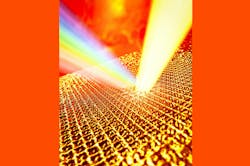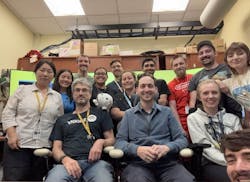LCLS lets researchers explore superheating and limits of solid-state matter
A team of researchers led by Bob Nagler and Thomas White recently demonstrated a new method to measure the temperature of atoms within warm dense matter—by directly measuring the speed of atoms.
Materials all possess specific melting and boiling points, but can be superheated above them until they reach an entropy “catastrophe” level of sudden melting and boiling.
When the team superheated solid gold far beyond its theoretical limit to 19,000 kelvins, it survived the entropy catastrophe—which suggests there may not be an upper limit for superheated materials if they’re heated quickly enough.
Laser Focus World: Whose idea was it to superheat gold with LCLS? What inspired it?
Bob Nagler: When we set out to do the experiment, our goal was to develop a new method to measure the temperature of warm dense matter. This matter is as dense as a solid, but heated to tens or hundreds of thousands of degrees Kelvin. You find it in giant planet cores and stellar interiors, but when we recreate it in the lab, actually measuring its temperature is infamously difficult.
We launched this project to address this challenge, using the world’s brightest x-ray source, SLAC National Accelerator’s Linac Coherent Light Source (LCLS), to help.
Thomas White: I’d love to say it was a lone-wolf flash of brilliance but, in truth, the idea came out of long-standing frustrations across the field. We knew we needed a better diagnostic, and gold made the idea test material: it scatters x-rays well and can be easily made into the thin foils required for this technique. Our team at the University of Nevada, Reno, SLAC, and other partners expected the gold to heat up under irradiation, but what stood out was how hot the solid remained while maintaining its crystalline structure. Even at these extreme temperatures, the gold lattice persisted beyond the expected limit for structural order. This observation shifted the focus of our project. What began as a practical effort to build a better thermometer evolved into a deeper investigation of superheating and the fundamental limits of solid-state matter under extreme conditions.
LFW: What does this mean for high-energy-density physics?
Nagler: Measuring the temperature of high-energy-density systems has long been a missing piece in the experimental toolkit. This work fills that gap by providing a direct model-independent way to measure ion temperatures in extreme conditions. It’s a significant advance for high-energy-density physics, with broad implications across geophysics, planetary and astrophysics, and inertial confinement fusion.
White: Accurate temperature measurements are essential for validating models, constraining equations of state, and ultimately improving our understanding of matter under some of the most extreme conditions in the universe.
LFW: What does this mean for inertial confinement fusion?
Nagler: While this technique isn’t aimed at measuring the temperature of fusion fuel itself, which is typically much hotter, it has important implications for the materials exposed to the intense radiation and particle fluxes generated within fusion environments. Understanding how solids behave under ultrafast, high-temperature, nonequilibrium conditions is key to designing materials that can survive the extreme environments found in fusion reactors, particularly in wall and diagnostic components.
LFW: What’s next?
White: We recently completed an experiment measuring the temperature of iron as it undergoes shock melting, using a 100-J, 10-ns pulse from a Nd:glass laser. Since the Earth’s core is primarily composed of iron, accurately determining its temperature under such extreme conditions is of major interest for geophysics. These long-pulse lasers allow us to compress and heat materials to pressures comparable to those found at the centers of planets, which makes them a powerful tool for probing planetary interiors in the lab. We’ve only just begun analyzing the data, but the initial results look very promising.
Nagler: Looking ahead, we’re also planning future experiments focused on materials and conditions directly relevant to inertial confinement fusion, particularly how matter behaves when exposed to intense radiation and particle fluxes.
FURTHER READING
T. G. White et al., Nature, 643, 950–954 (2025); https://doi.org/10.1038/s41586-025-09253-y.

